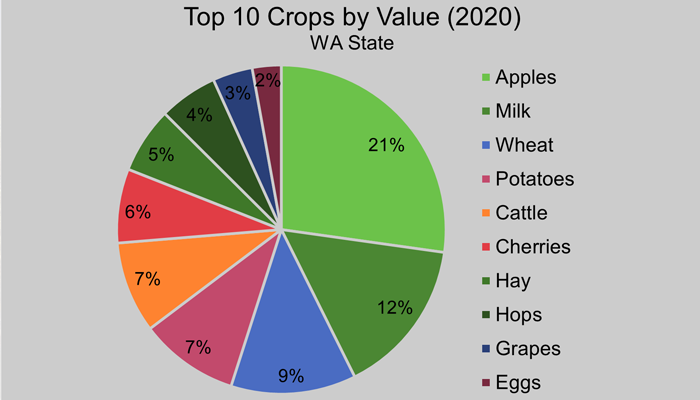The Capital Press released an article last month detailing the top ten crops in Washington State by value in 2020 according to NASS statistics. The total production value was $10.2 billion, an impressive figure! This blog post is a spotlight on agriculture in Washington as we wrap up another “fruitful” year of farming.
Here are the stats:
| 1. Apples: | $2.1 billion |
| 2. Milk: | $1.19 billion |
| 3. Wheat: | $949 million |
| 4. Potatoes: | $753 million |
| 5. Cattle: | $693 million |
| 6. Cherries: | $562 million |
| 7. Hay: | $500.74 million |
| 8. Hops: | $444.9 million |
| 9. Grapes: | $302.1 million |
| 10. Eggs: | $220 million |
There is no question that the official state fruit should remain the apple. Red Delicious, Gala, and Fuji varieties still make up half of the total production. However, more and more “boutique” and club varieties are making their way onto grocery store shelves. If you haven’t tried an Ambrosia, Opal, Lemonade, or SugarBee, those are a few of my favorites.
Production value may have risen by 7% from 2019 to 2020, but expenditures rose 15% over the previous year. That is a significant jump! As for many industries and businesses, labor costs topped the charts for Washington growers as the number one expense, making up 27% of expenditures, according to NASS.
As a farm labor software provider, we try to keep up with the rules related to agricultural workers One challenge is every state plays by different rules. The second biggest challenge, these rules seem to be constantly changing. Our Washington farmers are up against complex employee labor laws—especially if they pay workers piece rate. Starting January 1, 2021, agricultural operations in the Evergreen Statue must track the following:
Minimum Wage
Washington State will top the nation with the highest minimum wage. In less than two months, minimum wage will jump from $13.69 to $14.49, a 5.8% increase. Back in 2012, just 10 years ago, the state minimum wage was only $9.04. In a decade, the minimum wage increased by 60%!
Paid Breaks
Many growers are now accustomed to tracking paid break time for piece rate workers to ensure that they are getting compensated for rest breaks. This calculation can get complicated since the rate of pay varies per employee. The rest break pay is based on the worker’s average weekly hourly piece rate. The logistics of having employees log break time is a challenge itself. Accurately tracking break time and performing the complex calculations can make payroll a headache. For farms that have not upgraded to digital tracking and comprehensive payroll software, it can be a real nightmare!
Nonproductive Time
Tracking nonproductive time applies to piece rate workers. When fruit pickers, for example, must move to a different field or perform work related to the harvest that does not directly earn them pieces, the farm must compensate them for this time at the state’s minimum wage rate. This time must be tracked separately, adding another layer to track for field and office staff.
Overtime
Starting January 1st, Washington State farms must start paying all agricultural workers for overtime. Any hours that exceed a 55-hour work week will be compensated at time and a half. The new rule will phase in over three years. They ensure overtime pay for any time worked over 48 hours a week in 2023 and 40 hours a week by 2024.
Washington farms and orchards are up against a lot. In recent months, fertilizer prices and other input costs have increased dramatically as well. Labor is only one piece of the puzzle, and growers will have to get more creative and efficient to meet the new and continued challenges of farming. However, I am impressed, and proud to live in a state that provides so much food for the country and even outside of our borders. At 2nd Sight, we hope to support and collaborate with farms of all sizes to ensure the success of the industry as we move forward.

